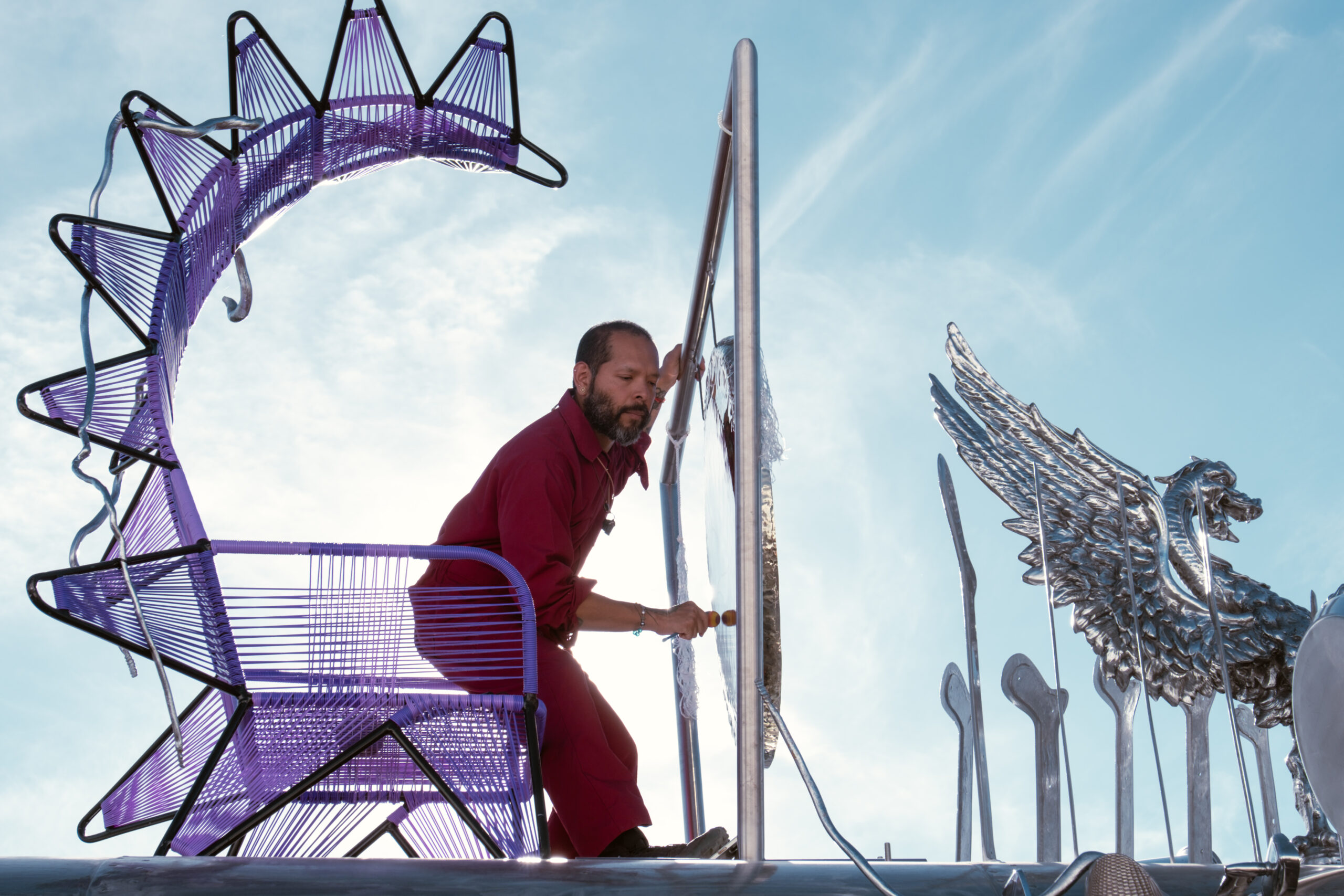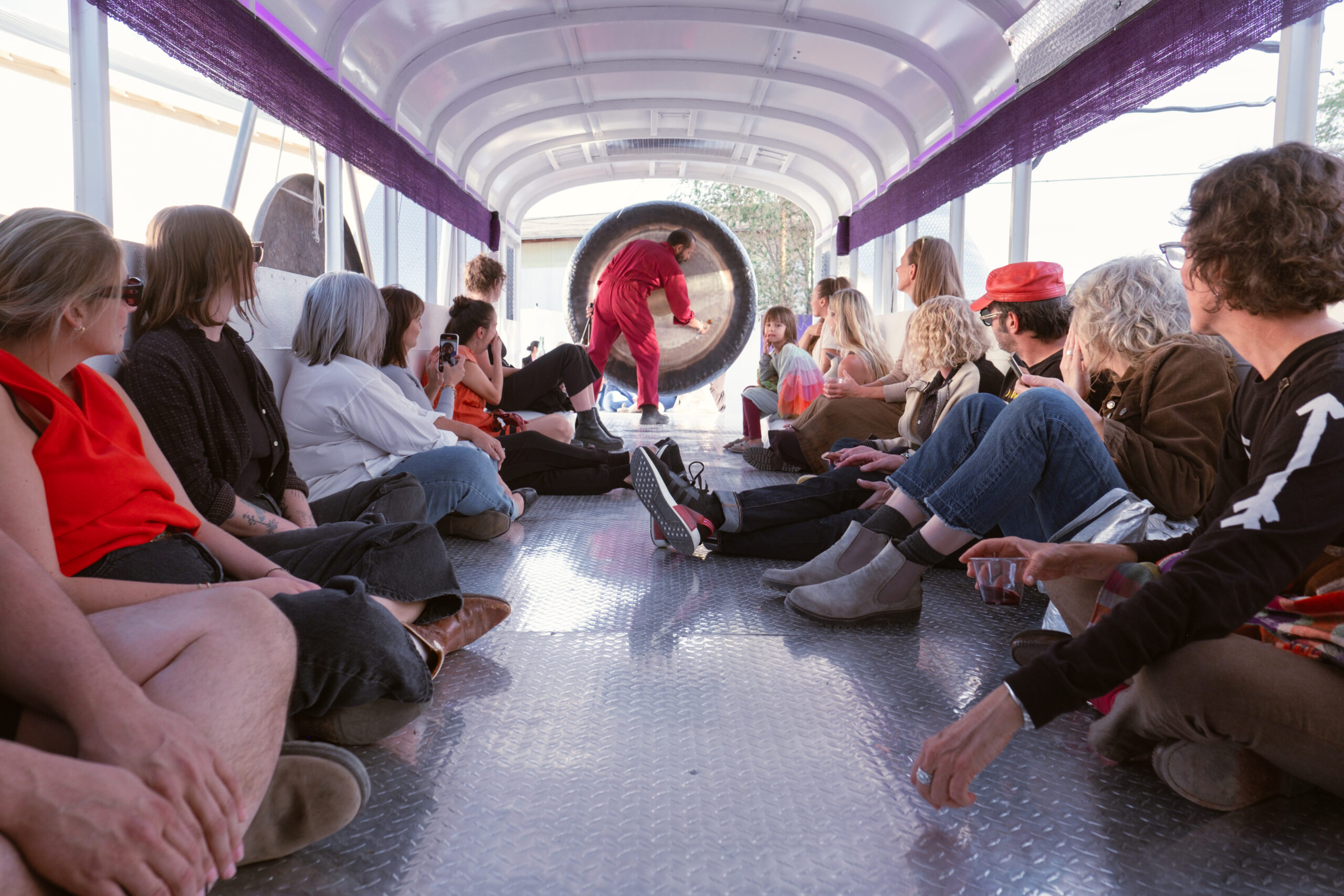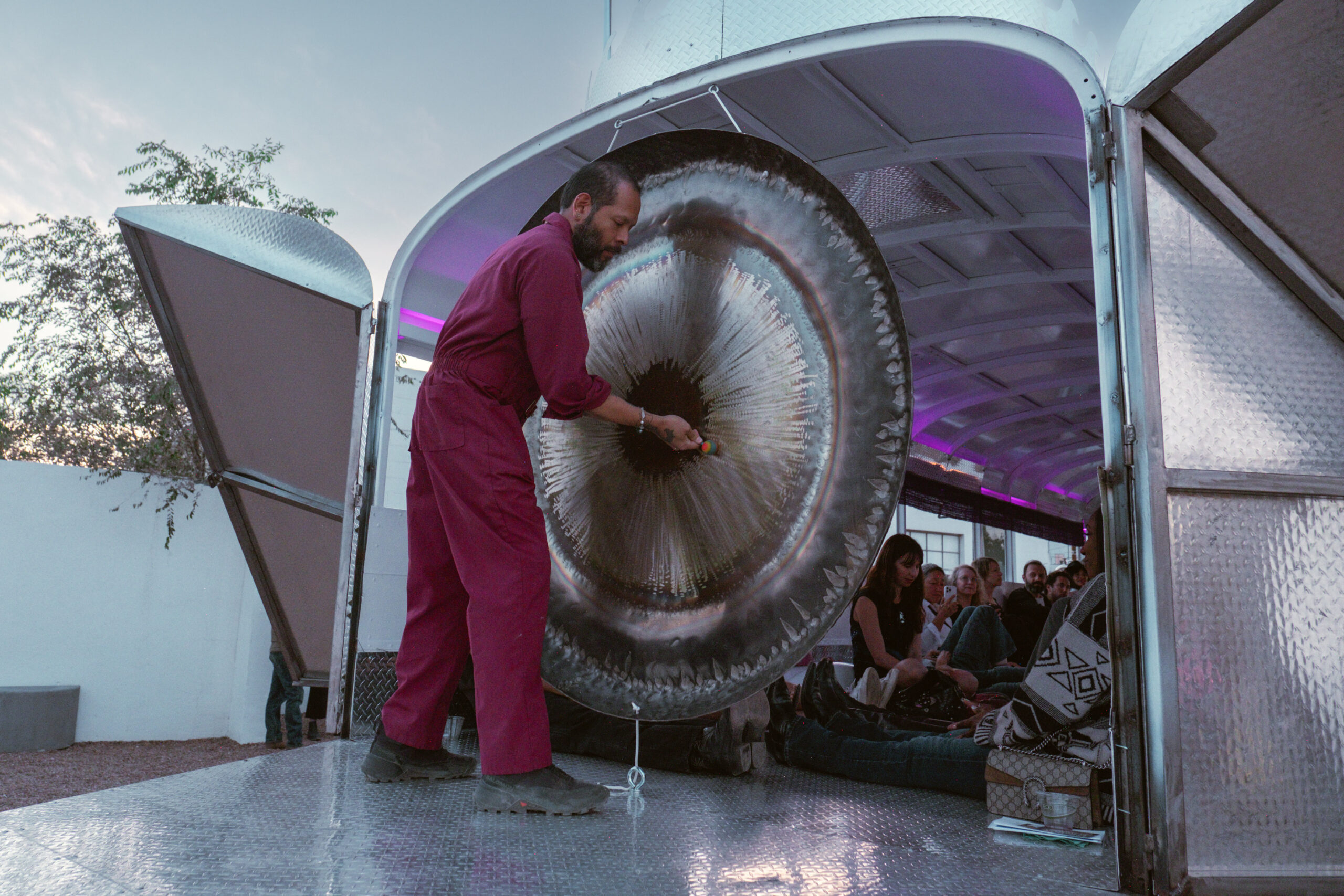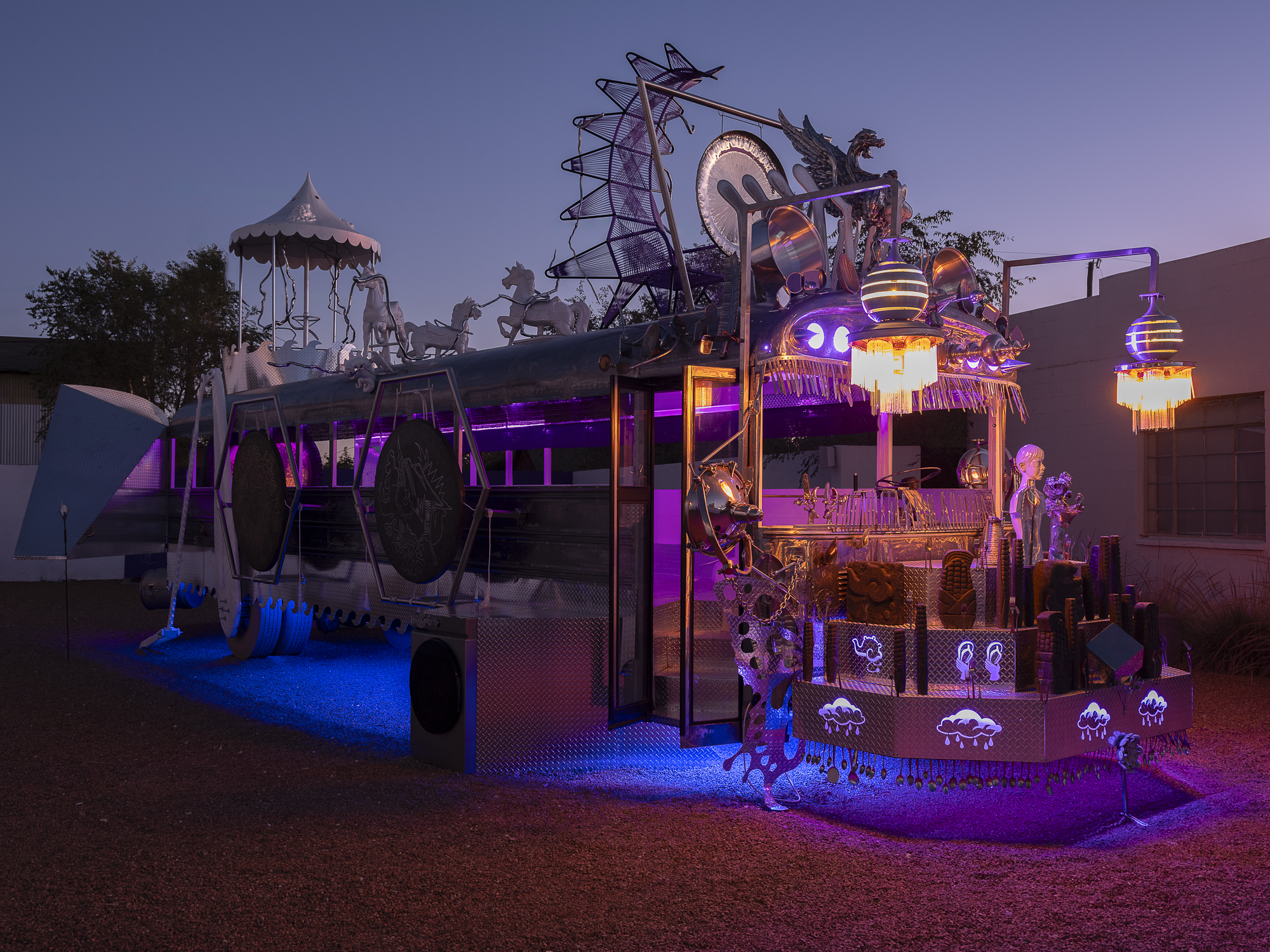
In Texas, a three hour drive from El Paso, Marfa sits between a stretch of wide-open skies and rocky mountain ranges, flanked by Highways 90 and 67. Sometimes, at night if you drive out past the small cluster of art galleries, mom-and-pop shops, famed Donald Judd installations, and municipal buildings—and into the Chihuahuan Desert—you might spot the Marfa Mystery Lights: glowing orbs that appear to bounce frantically in the Big Bend horizon, appearing and disappearing on a whim to the confoundment of scientists. This natural phenomenon has captured the imagination of sceptics and dreamers alike; it is a sort of mascot and metaphor for the Far West Texas outpost.
For some locals, the real Marfa lights are the stars that engulf the rural hamlet and its outskirts once the sun sets: a vast and impenetrable sheet of shining white specks, illuminated in the tar-black sky. For others, the Marfa lights are the glaring headlights of Border Patrol sedans, either simmering in the shadows on the side of the road or darting past in high-speed chases.
Here, nestled on one side of what has been deemed one of the last American frontiers, sits Ballroom Marfa. The white adobe-walled, light-filled space was once (like its name suggests) a 1920s-era ballroom before it was reborn in 2003 as a nonprofit arts institution that is ushering in a new generation of artists to reckon with the town’s past and offer a new, more inclusive vision for its future.
Out front, a silver carousel horse pokes up from the building’s courtyard, hinting at Guadalupe Maravilla’s Mariposa Relámpago, a spectacular, shining repurposed school bus within. The immersive healing instrument is a labour of love for the El Salvador-born, Brooklyn-based artist, a work born from his desire to transmute therapeutic rituals through tangible shapes and sounds. It has arrived from Mexico by way of the East Coast (where it was commissioned and debuted at the ICA Boston in May), and it will go to The Contemporary Austin in April and then the Blaffer Art Museum in Houston next year. Like a butterfly retracing its migration, the artist’s bus follows his own childhood journey from El Salvador to the United States.
“It was really important to start here,” Maravilla emphasises. “There’s so much history in Marfa. You can feel it. This is native land.”

As an eight-year-old, Maravilla fled the civil war that washed a perpetual state of terror over his homeland, lasting 12 years. Unaccompanied, he crossed the Tijuana border in the middle of the night and set off to New York City. His path to US citizenship took over 30 years, during which the trauma manifested in the form of stage 3 colon cancer while he was a graduate student at Hunter College (this month marks his 10-year anniversary of being cancer free). A desire to connect with El Salvador’s lost indigenous traditions—and a distrust in the health system run by the same government that deemed him an “illegal alien”—Maravilla set out to explore alternative, holistic methods of healing.
He met with shamans, medicine men, and sonic healers and unlocked a new realm of possibility within art, sound, and movement that has permeated through his practice ever since. With his cancer in remission, Maravilla continued his journey in pursuit of methods of therapy outside of Western medicine that he could share with the undocumented community as well as the cancer community.
On a brisk, early November in Marfa, the afternoon sun bounces and beams off of 600-plus metallic objects that adorn his bus’s exterior—wood dipped in chrome, silver spoons, a dozen white onyx eggs, all sourced from over the artist’s trips throughout Central America and soldered together in Mexico City. Each object contains a meaning and acts as a transmitter for the sound that rings out from four large metal gongs tuned to the frequencies of Earth and water.
At Ballroom Marfa, on Mariposa Relámpago’s opening night, Maravilla coaxes soaring and simmering sounds out of the installation-turned instrument. Locals spanning generations and art-tourists from Austin and Dallas pile in to experience the sound bath as the sun slowly sets and the bus begins to radiate with a purple light. Children run and clamour around its washing-machine-wheels and stretch out across its metal floor.

Maravilla had wanted to invite undocumented migrants to the activation, but the risk of outing their status was too high at a time when Texas’s immigration laws have become increasingly severe (and talks of a law that would make illegal entry to Texas a state crime send a shiver through Marfa).
Miguel Mendías, a local artist of Native American heritage and roots in Marfa, gathers round to watch Maravilla’s ceremony unfold. He sits to the front of Maravilla’s bus, in a trance as the artist bangs his gong. Mendías returned to the town in 2016 to rescue his family’s 120-year-old adobe house from foreclosure. He embarked on a spiritual journey of reconnection with the land that culminated in learning the traditional adobe practice and a soon-to-come ceremony where he will marry his house. Like Judd and the mostly white land artists of decades past, a new wave of artists are probing at the relationship between land and structures, pushing the connection to compelling and challenging ends.
In front of Ballroom, as the final echoes of the music dissipate and people slowly trickle out, another local artist speaks soberly of the Marfa’s history of segregation that reverberates in its architecture. Off of route 90, a cemetery pokes out of brown dirt, neatly manicured and grassy; its tombstones inscribed with the names of white residents. Two other cemeteries lie across a fence, near the railroad tracks; crosses and colourful flowers mark the graves of Marfa’s residents of Mexican descent. While this division wasn’t written in the law, a racial divide ran through the town. Elsewhere, the Blackwell School (which closed in 1956 and is now a Mexican-American community centre) is a reminder of the de facto segregation that once resulted in its students being forced to write “I will not speak Spanish in school or on the playground” on pieces of paper that were then buried in the ground underneath the flagpole.
Here, on native land, the bus is a stand-in for those whose travels are kept secret, carried out in the middle of the night, through rivers and over mountains—and in Maravilla’s case when he was a child—in a truck bed hidden under two large, white dogs. There is a reason why those undocumented are often referred to as invisible, a term that is as violent as it is evocative of their efforts to hide, stay under the radar, assimilate, lose whatever “otherness” that makes them stand out.
“When I first came up with the idea of using the bus, it was around the time when they started busing people to New York from Texas,” recalls Maravilla. The news reinforced his desire to reappropriate the vehicle as a vessel for healing. “I’m building my toolkit with all of the medicine that I’m picking up along the way. Look at the world we are living in right now with what’s happening on the Gaza Strip, there is no end to it,” he says.

“During our sound baths, we’re playing with intention,” Maravilla says. “We’re thinking of what’s happening politically in the world, what’s happening with the audience, what’s happening in the place that we’re playing in. We’re meditating and sending energy to everyone in the space.”
One mile West in Valentine, at the Texas-Mexico border, giant buoys float, foreboding in the river. These attempts to dissuade crossing are causing people to drown—word around town is that if the buoys don’t work, the border patrol officers are instructed to push migrants back into the frigid water. Those who make it onto shore, arrive soaking wet with few to no belongings. They might be lucky to find momentary refuge in a nearby house, but even this is fraught with violence. “I’ll let people in to use the phone, but usually a bus comes by to pick them all up within minutes to deport them, tipped off by neighbours,” says a Valentine local whose property skirts the river.
Stories of exile and displacement vibrate through Maravilla’s work. On his gongs, intricate, fingerprint-like maps loop and leap into landscapes both imagined and real: They are the product of a two-person game called tripa chuca that Maravilla first learned while passing time waiting for the night to come between resting stops as he fled El Salvador. He later repurposed this in his practice, inviting young undocumented migrants from around the world to play with him during exhibitions and after-hours, safely in private. (One 18-year-old that Maravilla played with at the Whitney in 2018 is now one of the artist’s studio assistants.) The game, where each player draws lines to connect pairs of numbers, often leads to an exchange of personal stories as the players take turns, which then materialise in the work.
Here, in the small Texas town, Mariposa Rélampago is defiant and steadfast in its visibility: a placeholder for the nearly 2 million undocumented immigrants in Texas, a number that is likely higher due to the incentive for members of the community to avoid self-reporting their status.
“Coming here is really charged for me,” says the artist. “Sometimes I’m just relaxing, having a beautiful long drive, and then the Border Patrol drives right by me, looking at me. I’m just like, oh God, what are they going to do? Even now that I’m a citizen.” On a recent half-hour drive to the nearest supermarket, Maravilla forgot his wallet, which contained his identification. “They can just pull me over and arrest me and deport me if they want to,” he worried as the vast desert became oppressive in its openness—no place to hide—“What if I don’t have my phone and I can’t call anyone?” he says.

At home in New York, the artist syncs up with his community, hosting sound baths every Saturday in a Brooklyn church that he first encountered during the early months of the pandemic after he had raised around 80,000 dollars and was looking for a way to distribute it to the undocumented community. A fateful meeting with a pastor-turned-community leader led to a symbiotic relationship between the church and the secular artist who bonded over a shared desire to help those in need.
In March, when Maravilla will return to Marfa to once more activate the bus, he imagines a ceremony that could penetrate the source of all of this violence and aggression at the border. “I want to do a sound bath with somebody for border patrol and have a conversation with them about the work they’re doing,” he tells me. “A lot of them are Mexican descendants, and they’re being brutal with the undocumented community.” The artist notes that working for border patrol is one of the few well-paying jobs in the area, and often the ones enforcing the laws aren’t the ones creating them. “I don’t blame them for taking the job,” he says. “But I think it’s really important to get to the source of the problem. Can you do that work and still care?”
Words by Meka Boyle
“Mariposa Relámpago” is on view through March 16, 2024 at Ballroom Marfa in Marfa, TX.
Find out more





